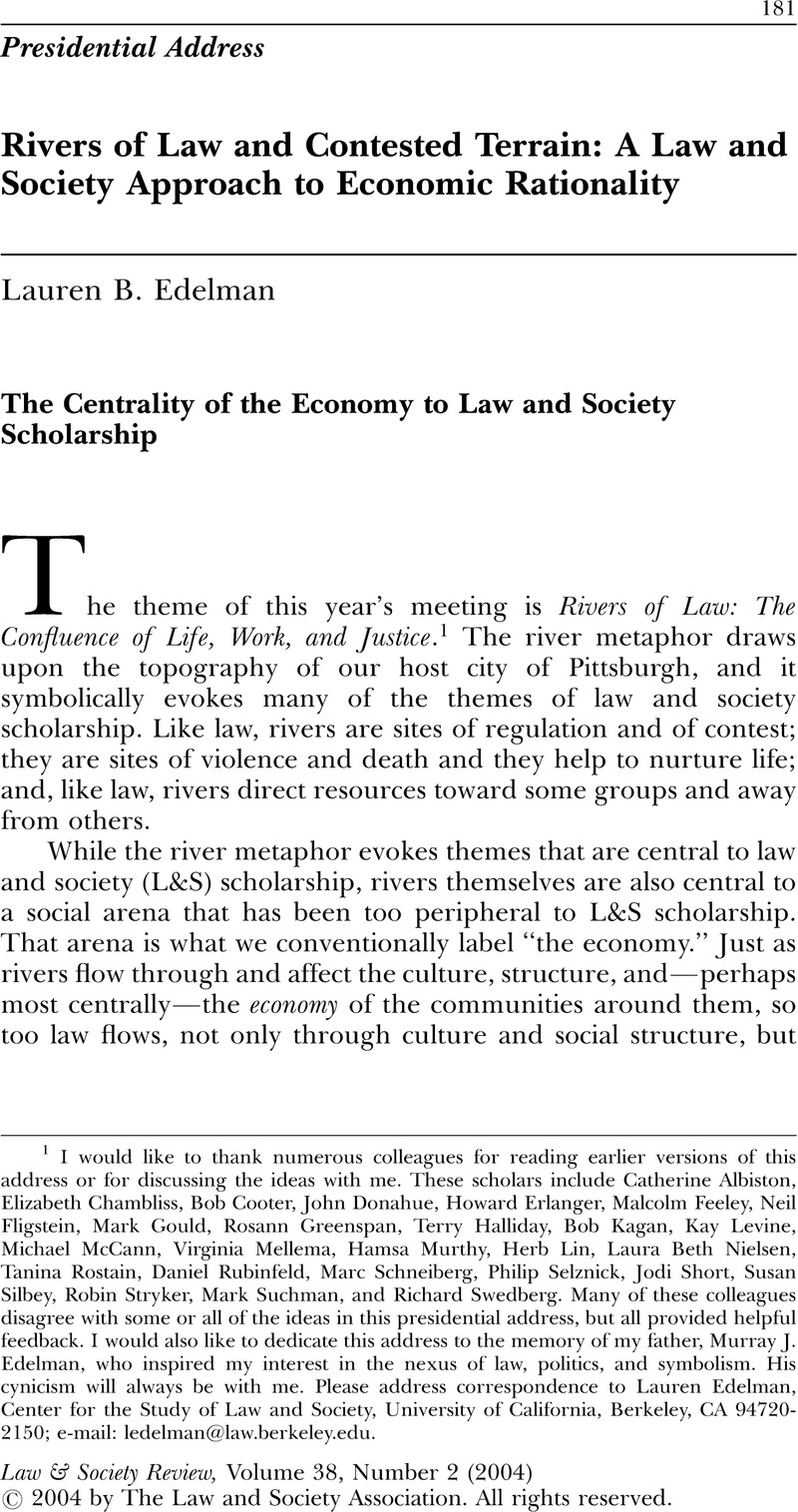Crossref Citations
This article has been cited by the following publications. This list is generated based on data provided by Crossref.
Halliday, Terence
2004.
Crossing Oceans, Spanning Continents: Exporting Edelman to Global Lawmaking and Market-Building.
Law & Society Review,
Vol. 38,
Issue. 2,
p.
213.
Epstein, Lee
and
Knight, Jack
2004.
Building the Bridge from Both Sides of the River: Law and Society and Rational Choice.
Law & Society Review,
Vol. 38,
Issue. 2,
p.
207.
McAdams, Richard H.
2004.
Cultural Contingency and Economic Function: Bridge-Building from the Law & Economics Side.
Law & Society Review,
Vol. 38,
Issue. 2,
p.
221.
Friedman, Lawrence M.
2005.
Coming of Age: Law and Society Enters an Exclusive Club.
Annual Review of Law and Social Science,
Vol. 1,
Issue. 1,
p.
1.
Erlanger, Howard S.
2005.
Organizations, Institutions, and the Story of Shmuel: Reflections on the 40th Anniversary of the Law and Society Association.
Law & Society Review,
Vol. 39,
Issue. 1,
p.
1.
FAIRMAN, ROBYN
and
YAPP, CHARLOTTE
2005.
Enforced Self‐Regulation, Prescription, and Conceptions of Compliance within Small Businesses: The Impact of Enforcement*.
Law & Policy,
Vol. 27,
Issue. 4,
p.
491.
PICKERILL, J. MITCHELL
JACKSON, ROBERT A.
and
NEWMAN, MEREDITH A.
2006.
Changing Perceptions of Sexual Harassment in the Federal Workforce, 1987–94.
Law & Policy,
Vol. 28,
Issue. 3,
p.
368.
Kahancová, Marta
2007.
One Company, Four Factories: Coordinating Employment Flexibility Practices with Local Trade Unions.
European Journal of Industrial Relations,
Vol. 13,
Issue. 1,
p.
67.
Conti, Joseph A.
2008.
The Good Case: Decisions to Litigate at the World Trade Organization.
Law & Society Review,
Vol. 42,
Issue. 1,
p.
145.
McAdams, Richard H.
and
Nadler, Janice
2008.
Coordinating in the Shadow of the Law: Two Contextualized Tests of the Focal Point Theory of Legal Compliance.
Law & Society Review,
Vol. 42,
Issue. 4,
p.
865.
Boyle, Elizabeth Heger
and
Kim, Minzee
2009.
International Human Rights Law, Global Economic Reforms, and Child Survival and Development Rights Outcomes.
Law & Society Review,
Vol. 43,
Issue. 3,
p.
455.
Gleeson, Shannon
2009.
From Rights to Claims: The Role of Civil Society in Making Rights Real for Vulnerable Workers.
Law & Society Review,
Vol. 43,
Issue. 3,
p.
669.
FRAZER, ANDREW
2009.
INDUSTRIAL RELATIONS AND THE SOCIOLOGICAL STUDY OF LABOUR LAW.
Labour & Industry: a journal of the social and economic relations of work,
Vol. 19,
Issue. 3,
p.
73.
Abel, Richard L.
2010.
Law and Society: Project and Practice.
Annual Review of Law and Social Science,
Vol. 6,
Issue. 1,
p.
1.
Kelly, Erin L.
2010.
Failure to Update: An Institutional Perspective on Noncompliance With the Family and Medical Leave Act.
Law & Society Review,
Vol. 44,
Issue. 1,
p.
33.
Edelman, Lauren B.
Leachman, Gwendolyn
and
McAdam, Doug
2010.
On Law, Organizations, and Social Movements.
Annual Review of Law and Social Science,
Vol. 6,
Issue. 1,
p.
653.
Frerichs, Sabine
2011.
False Promises? A Sociological Critique of the Behavioural Turn in Law and Economics.
Journal of Consumer Policy,
Vol. 34,
Issue. 3,
p.
289.
Sallaz, Jeffrey J.
2012.
Politics of Organizational Adornment.
American Sociological Review,
Vol. 77,
Issue. 1,
p.
99.
Gómez, Laura E.
2012.
Looking for Race in All the Wrong Places.
Law & Society Review,
Vol. 46,
Issue. 2,
p.
221.
Frerichs, Sabine
2012.
Studying Law, Economy, and Society: A Short History of Socio-Legal Thinking.
SSRN Electronic Journal,



